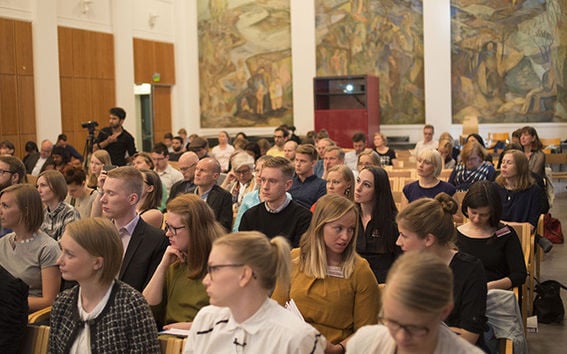New policy ideas by students for a sustainable and circular economy

Students addressed three project briefs: how the new National Waste Plan can reduce the amount of electronic waste, how housing companies can save energy and perform systematic maintenance, and how mobility services can be improved in rural areas. These projects were commissioned by the Ministry of the Environment and the Ministry of Transport and Communications.
Students in the course this year come from three universities and nine different programmes, ranging from design to media and from economics to social sciences.
More information management – less waste
Finland produces 20 kilograms of electronic waste per person each year. Based on their research, the students argue that recycling is not enough and that solutions have to focus on sustainable products and maintenance to prevent waste in the first place.
A national upkeep plan could guide policy, the need for repair services would create work and consumers would receive tax breaks and counselling at a Repair Day event modelled on the Restaurant Day concept. A label attached to products could promote a circular economy. How does this sound?
'Promising and viable! It's a lot more difficult to specify binding legislative actions for re-use and repairability than for things like energy efficiency and environmental friendliness. An easy-to-read and recognisable label could support this work,' says Senior Researcher Petrus Kautto from the Finnish Environmental Institute.
Kautto believes that a new report by the Prime Minister`s Office, Circular Economy in Finland, will also support the students' idea about the business opportunities related to a culture of maintenance. Information management could also accelerate this issue, and that is an area in which Finland has a lot of competence.
'One possible solution could be a kind of electronic ID attached to the product, which would contain information about raw material and repairs and thus improve monitoring of valuable raw materials,' continues Kautto.
The professor responsible for the Design for Government course at Aalto University considers the student proposals to be both serious and ambitious. 'Rather than being limited to small-scale and incremental solutions, the proposals go a lot deeper into attitudes and cultural change,' says Professor Ramia Mazé. ’
Mobility solutions by users for users
In order to increase transport options and reduce the use of private cars in rural areas, public transport needs an image makeover and a new vision for flexible mobility.
The students’ proposals see local people and associations in rural areas as active participants. They propose the digital applications LIIKE and Verka to bring together those with transport needs and those who offer transport services. For example, Verka could propose results in carpool commuting for people who would otherwise need a car or have long public transport journeys. What does the commissioning ministry have to say about this?
“You nailed it!’ says Senior Officer Krista Huhtala-Jenks from the Ministry of Transport and Communications. 'The starting point for these proposals is very good: people don't need to own a car. Tools for sharing information already exist, for example, on social media, but we don't have a service that would bring together all of the mobility needs and service providers. This project provides some interesting proposals in that area.'
Both LIIKE and Verka solutions are good examples of platform economy. Digital applications bring together all of the mobility needs and service providers and make flexible travelling possible in the rural areas.
Is design for government the future?
Of course! Design has a lot to contribute to better understanding and designing governmental policy. For example, human-centered design makes policy-making processes more accessible within the ministries as well as the actual policies more tailored to citizens.
'The students have succeeded in making the ministry's everyday and abstract tools, such as numbers and legal paragraphs, more concrete and visual. They have also combined information in a new way and clarified the big picture for which we are seeking solutions,' says Counsellor Taina Nikula from the Ministry of the Environment.
'The student proposals can be linked to a lot of ongoing processes at the Ministry of the Environment. At the same time, we also need more understanding and support for strengthening the design perspective,' says Nikula.
The Prime Minister's Office has also shown interest for several years in the role of that design can play in developing government.
'Strengthening a culture of experimentation is one of the government's spearhead projects, and methods for achieving this goal are being taken from behavioural sciences and design. At the same time, we want to promote a change in the culture of developing things – and this is where service design comes into play,' says Project Manager Ira Alanko.
Design For Government is an advanced studio course in Aalto University’s Creative Sustainability Master’s Programme. Design for Government develops design addressing the complex challenges of the government and public sector. Eight project briefs have been commissioned by Finnish ministries and Prime Minister’s Office since the course started in 2014.
- Published:
- Updated:
Read more news

DeployAI Partners Gather for Heart Beat Meeting in Helsinki
The European DeployAI project's partners gathered for the Heart Beat meeting hosted by Aalto University Executive Education in Helsinki.
Get to know us: Associate Professor Maria Sammalkorpi
Sammalkorpi received her doctorate from Helsinki University of Technology 2004. After her defence, she has worked as a researcher at the Universities of Princeton, Yale and Aalto.
Aalto computer scientists in ICML 2024
Computer scientists in ICML 2024